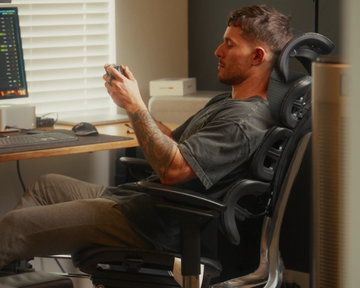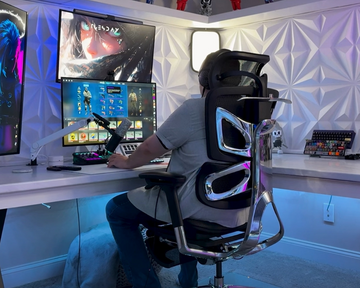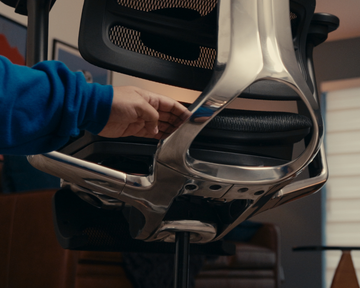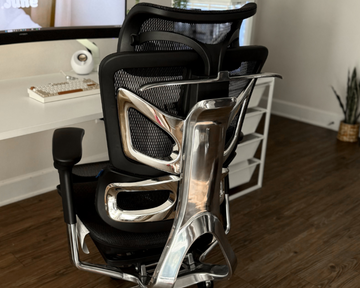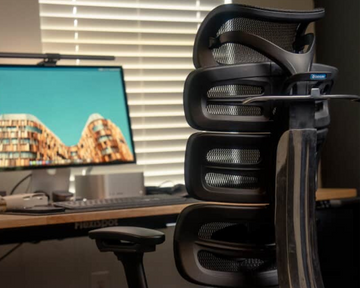For tall individuals, selecting the ideal office chair can pose a significant challenge. Spending extended periods in an uncomfortable chair can result in back pain, neck strain, and overall discomfort, ultimately impacting productivity and focus. So,what makes an office chair truly ideal for tall individuals? Let’s explore the essential features and pick out the best office chair for tall men.
Why Tall People Need Special Office Chairs?
Tall persons have unique needs for office chairs. They require a chair with a high backrest to support the full spine, especially the upper back and neck, and a deep seat for proper thigh support to avoid knee discomfort. Adjustability is equally crucial, given that a perfect fit requires more customization features, such as the ability to adjust the seat, backrest, and the height and width of the armrests.
Pairing a tall-friendly chair with an ergonomic desk with chair designed for height adjustability can dramatically improve posture and reduce fatigue during long hours of sitting or standing.
Key Features of the Best Office Chair for Tall Person
When selecting the best ergonomic desk chair for tall people, it is crucial to recognize that they have distinct physical requirements. These requirements necessitate specific features in the chair to guarantee comfort, support, and proper posture during extended periods of sitting. Here are the key features that set an office chair apart as the optimal choice for tall people:
1. High Backrest
A high backrest (at least 22 inches) extending to the upper back and neck, with adjustable headrests, is essential for tall people.
2. Deep Seat
Seat depth should be about 20 inches or more to support thighs fully, preventing knee pressure and ensuring proper blood circulation.
3. Adjustable Lumbar Support
Adjustable Lumbar Support is crucial for maintaining good posture, which enables tailoring support to fit the spine's natural curve.
4. Adjustable Armrests
For tall individuals with longer arms, adjustable armrests that can be moved vertically, horizontally, inward, and outward are of vital importance in keeping their arms and shoulders at ease and reducing strain.
5. Sturdy Base and Wheels
A five-star sturdy base of durable materials is needed to support tall people's weight and height; high-quality wheels ensure smooth movement on various floors.
Top Picks for the Best Office Chair for Tall Person
For tall individuals, finding an office chair that truly fits their body and provides all-day comfort can be a real challenge. We've scoured the market and carefully selected the 5 best office chairs for tall persons, each rigorously evaluated for comfort, adjustability, and tailored support to meet the unique needs of taller individuals.
1. OdinLake O2 (Ergo MAX 747)
The Ergo MAX 747 is designed for tall people. Its three-section backrest offers targeted support to different spine segments, easing strain. The high backrest covers the full spine up to the neck, ideal for those with upper back and neck issues. The deep seat fits long thighs, avoiding knee pressure. Adjustable backrest height and armrests enable a personalized, comfortable fit and good posture for long workdays, making it the best for tall office workers.
Key Features
Three-Section Backrest
Offers targeted spinal support, addressing the specific needs of taller spines.
High Backrest
Provides full-spine coverage from the lower back to the neck, a must-have for tall individuals.
Deep Seat
Ample thigh space to prevent knee pressure, ideal for long-legged tall users.
Adjustable Components
Backrest height and armrests can be tailored for a perfect fit.
2. OdinLake O3 (Ergo BUTTERFLY 753)
The OdinLake O3 is a game-changer for tall individuals seeking an ergonomic office chair that perfectly fits their needs. With its innovative design and advanced features, it provides unparalleled comfort and support for long workdays.
Key Features
High Backrest with Butterfly Split Design
753 chair, five-height adjustable, covers full spine to neck, supports upper back, promotes good posture.
Deep Seat
O3 chair, seat depth adjustable, supports thighs, prevents knee pressure, aids circulation.
Dynamic Lumbar Support
C-shape, fits the spine curve, adjusts with movement, reduces stress, eases back pain.
WireControl Embedded Armrests
Inspired by car paddle shifters, quick chair setting adjustment for tall users without standing.
Sturdy Metal Chassis
Aluminum alloy, stable, durable, supports tall people, lasts up to 15 years.
Lockable Backrest Tilt
Locks at any angle from 90-135 degrees, flexible for work/relaxation.
3. Steelcase Leap
The Steelcase Leap is another excellent option. It offers exceptional adjustability, including a high backrest that can be adjusted to fit different heights. The seat is deep and comfortable, and the lumbar support is highly customizable. The chair is built to last and provides excellent support for tall people.
Key Features
Exceptional Adjustability
High backrest can be adjusted for different heights, accommodating tall users.
LiveBack Technology
Conforms to the user's back for dynamic support. Durable Construction: Built to last and provides good overall support.
Limitations
The spinal support is less specialized and targeted for tall spines when compared to chairs such as the Ergo MAX 747, and the design focus leans more towards overall ergonomic support rather than catering specifically to tall users' needs, which may leave some tall individuals unsatisfied.
4. Herman Miller Aeron
The Herman Miller Aeron is a favored choice among tall individuals. It features a high backrest, adjustable lumbar support, and a deep seat. The chair is highly adjustable, allowing you to fine-tune it to your body. It also boasts a durable base and wheels, making it a long-lasting investment.
Key Features
High Backrest and Adjustable Lumbar Support
Offer some support for tall individuals.
PostureFit Lumbar Support Technology
Adjustable for targeted lower-back support.
Limitations
The seat depth may be insufficient for tall users with longer thighs, thus affecting their long-term comfort, and the price is relatively high compared to some competitors, which could potentially impact the overall value for tall users.
5. Haworth Zody
The Haworth Zody has a high backrest with adjustable lumbar support and armrests, offering personalized lower-back support. Yet, for extremely tall users, its height and seat depth may fall short compared to Odinlake's chairs, making it more suitable for a general office audience.
Key Features
High Backrest and Adjustable Features
Lumbar support and armrests can be adjusted to suit individual needs.
Asymmetric Lumbar Adjustment
Allows for personalized lower-back support, promoting good posture.
Limitations
The overall height and seat depth may fall short of fully satisfying the needs of extremely tall users, thereby restricting long-term comfort, and the design is optimized more for a general office audience rather than addressing tall-specific requirements, potentially leaving some needs of tall users unmet.
|
Chair Model |
Best For |
Limitations |
Weight Capacity |
|
OdinLake O2 (Ergo MAX 747) |
Tall people seeking comprehensive support |
None for typical tall users |
Up to 350 lbs |
|
OdinLake O3 (Ergo BUTTERFLY 753) |
Tall people needing innovative ergonomic support |
None for typical tall users |
Up to 350 lbs |
|
Steelcase Leap |
Tall people valuing adjustability & durability |
Less specialized spinal support for tall spines; general ergonomic focus |
Up to 320 lbs |
|
Herman Miller Aeron
|
Tall people prioritizing brand & willing to pay premium |
Seat depth may be short for long thighs |
Up to 300 lbs |
|
Haworth Zody |
Tall people needing adjustability, not extremely tall |
Height & seat depth may not suit extremely tall; general office design focus |
Up to 300 lbs |
How to Choose the Right Chair
For tall people picking an office chair, follow these tips:
1. In-store testing (if possible)
Sit in the chair for 15-20 minutes. Check if feet can rest flat (or on footrest with knees at 90°). Adjust backrest for full spine support and armrest height for relaxed shoulders.
2. Online research
Read tall users' reviews, especially on back support, seat depth, and comfort. Check manufacturer's specs like max seat depth, backrest height, and weight limit to see if they fit.
3. Budget consideration
High-end chairs are comfy and durable, but mid-range or budget ones can also work. Think about long-term value by comparing initial cost with comfort and productivity gains.
FAQs
1. How often should an office chair for tall people be replaced?
The lifespan depends on quality and usage. Generally, a good-quality chair lasts 5-10 years. Replace it when discomfort arises or visible wear and tear is noticed.
2. Can gaming chairs be used as office chairs for tall people?
Some gaming chairs can work for tall people, but they may lack the professional ergonomic design of office chairs. If choosing one, make sure it has a high backrest and adjustable parts to fit a tall body.
3. What if a chair lacks all desired features for tall people?
Prioritize key features such as a high backrest and adjustable lumbar support. You can also use accessories like lumbar pillows or footrests to enhance comfort.
4. How important is the weight capacity of an office chair for tall people?
Tall people often weigh more, so a chair with a high weight capacity ensures stability and longevity.
Conclusion
In conclusion, finding the best office chair for tall people requires careful consideration of key features. Look for a chair with a high backrest, deep seat, adjustable lumbar support, and adjustable armrests. Odinlake's O2 (Ergo MAX 747) and O3 (Ergo BUTTERFLY 753) excel as the best office chairs for big and tall, perfectly addressing their unique needs. While Steelcase Leap, Herman Miller Aeron and Haworth Zody have merits, Odinlake shines with its specialized tall-user features. Picking the right chair means comfort, support, and better productivity during long workdays. Do not compromise on comfort; invest in a chair designed for your height.
Read more:
Best Office Chairs for 8-Hour Workdays
Best Ergonomic Chairs for Neck Pain in 2025: Comfort & Support Guide

